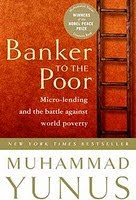Thinking About Microfinance
 I'm a little embarrassed that until this past weekend, I hadn't read Muhammad Yunus' Banker to the Poor. It was one of those glaring gaps into my personal and professional development that, looking back, is completely inexplicable. I probably shouldn't even be admitting this in public but I suppose it's never too late to get with the program.
I'm a little embarrassed that until this past weekend, I hadn't read Muhammad Yunus' Banker to the Poor. It was one of those glaring gaps into my personal and professional development that, looking back, is completely inexplicable. I probably shouldn't even be admitting this in public but I suppose it's never too late to get with the program.When I have a few moments to myself these days, I often find myself thinking about current aid structures and imagining how things might be different with the introduction of microfinance. Just this morning on my run, I was listening to a This American Life collaboration with Planet Money about NGOs in Haiti. They tell the story of a local mango farmer who has the land and the water for one hundred mango trees but needs a small canal to expand her business and the mango exporter who wants to distribute plastic crates to mango farmers because better packing methods would double his and the farmers' income.
The canal-building struck me as a great opportunity for a micro-loan since it sounded like the upfront investment in infrastructure was the main hurdle constraining growth. Meanwhile, the mango exporter with the crates first tried giving them away for free and then tried partnering with an NGO that later lost its funding after the earthquake. Neither scenario proved successful.
Part of the failure in the first approach was neglecting to take the time to demonstrate the economic value of fewer bruised mangoes to the farmers. Additionally, giving the crates away for free stunted any feeling of having a financial stake in the new packing method. If the farmers had first been convinced for themselves that changing their process could increase profits and then saved up or borrowed money in support of their business, they would have been more personally invested in the project. As it was, many crates ended up as chairs.
In the second scenario, bureaucracy, natural disaster, and fickle funding for NGOs delayed the project indefinitely. I have no way of knowing with certainty if microfinance opportunities could have changed the outcome for the mango farmer and the mango exporter but it seems like you'd be hard-pressed to do worse than the current system.
To bring this back to Malaysia, I'd love to hear more about your personal experiences with microfinance projects since Yunus mentioned that Malaysia was one of the first countries to adapt Grameen's banking model outside of Bangladesh. If you have any stories that you'd like to share, just leave a comment on this blog. Thanks!
Part of this post originally appeared at aditkowsky.wordpress.com.



Comments
Post a Comment